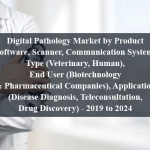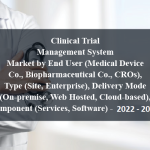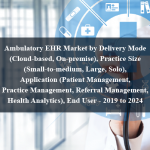OVERVIEW
Research by Global Market Studies has reported a CAGR of 23.1% for the Breast Cancer Liquid Biopsy Market, expecting to expand to a value of USD 1,465.33 million by 2028.
A liquid biopsy is a minimally invasive diagnostic procedure that involves the analysis of biological fluids, such as blood or urine, to detect and analyze genetic, molecular, or protein-based markers associated with cancer. In the context of breast cancer, liquid biopsy tests are used to identify and monitor genetic mutations, circulating tumor cells (CTCs), cell-free DNA (cfDNA), and other biomarkers that are indicative of breast cancer presence, progression, or response to treatment.
Liquid biopsy tests aid in early detection of breast cancer, monitoring treatment response, detecting minimal residual disease, enabling personalized treatment selection, providing prognostic information, aiding in research and clinical trials, and offering non-invasive monitoring. They also offer a non-invasive alternative to traditional tissue biopsies, making them valuable for patients not suitable for surgical biopsies.
Market Dynamics
Drivers:
The liquid biopsy market is driven by the need for early detection of breast cancer, personalized medicine, real-time monitoring of treatment response, and minimal residual disease detection. These non-invasive methods can lead to more effective treatment and improved patient outcomes. The growing trend towards personalized medicine in oncology allows oncologists to tailor treatment plans to individual patients. Liquid biopsies also enable real-time monitoring of a patient’s response to treatment, allowing timely adjustments based on changes in biomarker levels.
The ability to detect minimal residual disease is crucial for assessing cancer recurrence risk and guiding post-treatment strategies. Advancements in sequencing technologies and highly sensitive assays have improved the accuracy and reliability of liquid biopsy tests. Their non-invasive nature makes them more acceptable to patients, leading to increased compliance with cancer screening and monitoring protocols. The rising incidence of breast cancer worldwide also drives the liquid biopsy market.
Opportunities:
Liquid biopsy tests are used to identify genetic mutations and alterations associated with breast cancer. These tests can also detect circulating tumor cells (CTCs), cancer cells that have entered the bloodstream, providing information about the presence of cancer and its potential to spread. Liquid biopsies also analyze specific biomarkers, such as protein markers or genetic mutations, to aid in diagnosis, prognosis, and treatment selection. Companies offer monitoring kits and platforms for collecting, processing, and analyzing liquid biopsy samples, often including specialized equipment and reagents.
Data interpretation and reporting services are provided by these companies, providing actionable insights for healthcare providers. Some liquid biopsy tests are developed as companion diagnostics for targeted therapies, helping optimize treatment selection. Companies may also offer research services to pharmaceutical companies and research institutions, patient monitoring solutions, and clinical laboratory services. Overall, liquid biopsy tests play a crucial role in the diagnosis, prognosis, and treatment of breast cancer.
Restraints:
Liquid biopsy tests face several challenges, including high testing costs, reimbursement challenges, clinical validation, sensitivity and specificity, limited availability, regulatory hurdles, sample collection and handling, tumor heterogeneity, ethical and privacy concerns, educational and awareness campaigns, standardization, and competition with established breast cancer diagnostic methods. The cost of testing can be a barrier to access for some patients and healthcare systems, especially in regions with limited resources. Reimbursement policies may not fully cover the cost of liquid biopsy tests, making it financially challenging for patients and healthcare providers.
Clinical validation is ongoing, and some tests may lack sufficient clinical evidence, leading to skepticism among healthcare professionals. Liquid biopsies may not capture the full spectrum of tumor heterogeneity, potentially missing important information. Ethical and privacy concerns arise from the analysis of genetic and molecular data in liquid biopsies. Standardization is needed to ensure comparability of results across different laboratories and platforms.
Regional Information:
North America: The US and Canada are major players in the breast cancer liquid biopsy market, with the US having a well-developed healthcare system and high access to advanced diagnostic technologies, while Canada’s healthcare infrastructure is also strong.
Europe: Western Europe, including the UK, Germany, France, and the Netherlands, is implementing liquid biopsy technologies due to established healthcare systems and regulatory bodies like the EMA, while Eastern Europe may experience slower adoption due to economic disparities.
Asia Pacific : China, Japan, India, and Australia are major markets for liquid biopsy technologies due to their growing healthcare sectors, modernization initiatives, limited access to advanced diagnostics, and robust healthcare systems, with government initiatives driving adoption in these regions.
Recent Developments:
• In March 2023, REVEAL GENOMICS, S.L., a Barcelona-based biotechnology start-up seeking to revolutionize precision oncology through biomarker innovation, announced a new addition to its pipeline consisting of a novel biomarker approach in liquid biopsy for patients with advanced cancer. REVEAL GENOMICS machine learning-based technology applied to ctDNA was able to predict drug response and survival outcome in patients with metastatic breast cancer treated with endocrine therapy and CDK4/6 inhibitors.
• In March 2021, Roche launched DISCOVERY Green HRP chromogen detection kit to expand immunohistochemistry multiplexing in cancer research
Key Players:
F. Hoffmann-La Roche Ltd, Thermo Fisher Scientific Inc., Abbott, Agilent Technologies Inc., Merck KGaA, QIAGEN, Abcam plc., Cell Signaling Technology Inc., Koninklijke Philips N.V., Menarini Group, Genomic Health, Johnson & Johnson Private Limited., Medtronic, Siemens Healthineers, Biocept, Bio-Rad Laboratories, Fluxion Biosciences, Foundation Medicine, Sysmex Inostics, ExoDx, and Illumina.
Frequently Asked Questions
1) What is the projected market value of the Breast Cancer Liquid Biopsy Market?
– The Breast Cancer Liquid Biopsy Market is expected to reach a value of USD 1,465.33 million by 2028.
2) What is the estimated CAGR of the Breast Cancer Liquid Biopsy Market over the 2023 to 2028 forecast period?
– The Breast Cancer Liquid Biopsy Market is expected to grow at a CAGR of approximately 23.1% from 2023 to 2028.
3) Who are the key players in the Breast Cancer Liquid Biopsy Market?
– F. Hoffmann-La Roche Ltd, Thermo Fisher Scientific Inc., Abbott, Agilent Technologies Inc., Merck KGaA, QIAGEN, Abcam plc., Cell Signaling Technology Inc., Koninklijke Philips N.V., Menarini Group, Genomic Health, Johnson & Johnson Private Limited., Medtronic, Siemens Healthineers, Biocept, Bio-Rad Laboratories, Fluxion Biosciences, Foundation Medicine, Sysmex Inostics, ExoDx, and Illumina.
4) What are the drivers for the Breast Cancer Liquid Biopsy Market?
– The liquid biopsy market is fueled by early breast cancer detection, personalized medicine, real-time treatment monitoring, and minimal residual disease detection, facilitated by advancements in sequencing technologies and patient acceptance.
5) What are the restraints and challenges in the Breast Cancer Liquid Biopsy Market?
– Liquid biopsy tests face challenges like high costs, reimbursement, clinical validation, and limited availability. Ethical and privacy concerns, as well as competition with established methods, necessitate standardization.
6) What are the key applications and offerings of the Breast Cancer Liquid Biopsy Market?
– Liquid biopsy tests aid in early detection of breast cancer, monitoring treatment response, detecting minimal residual disease, enabling personalized treatment selection, providing prognostic information, aiding in research and clinical trials, and offering non-invasive monitoring.
7) Which region is expected to drive the market for the forecast period?
– Asia Pacific has the highest value share in the global market and is expected to dominate shares in forecast period.
Why Choose Us?
Insights into Market Trends: Global Market Studies reports provide valuable insights into market trends, including market size, segmentation, growth drivers, and market dynamics. This information helps clients make strategic decisions, such as product development, market positioning, and marketing strategies.
Competitor Analysis: Our reports provide detailed information about competitors, including their market share, product offerings, pricing, and competitive strategies. This data can be used to inform competitive strategies and to identify opportunities for growth and expansion.
Industry Forecasts: Our reports provide industry forecasts, which will inform your business strategies, such as investment decisions, production planning, and workforce planning. These forecasts can help you to prepare for future trends and to take advantage of growth opportunities.
Access to Industry Experts: Our solutions include contributions from industry experts, including analysts, consultants, and subject matter experts. This access to expert insights can be valuable for you to understand the market.
Time and Cost Savings: Our team at Global Market Studies can save you time and reduce the cost of conducting market research by providing comprehensive and up-to-date information in a single report, avoiding the need for additional market research efforts.












